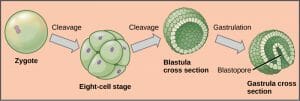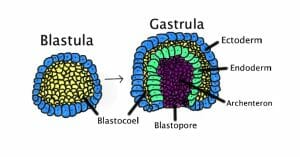Overview of Gastrulation
Gastrulation is a phase in the embryonic development of animals where the blastula reorganizes itself into a gastrula. It does this by folding itself inward as shown in Figure 1. This is a critical point in development because it is when the embryo transforms itself from a hollow sphere made from a single layer of cells into a multi-layered structure. The layers are called the primary germ layers; the endoderm, ectoderm, and mesoderm (Figure 2). Each species has its own uniqueness when it comes to the process of gastrulation, but there are similarities that span the entire animal kingdom. Frogs, chickens, and sea urchins are 3 species most studied by developmental biologists and comparative embryologists.

Figure 1: The image above shows the process of transformation from a single-celled zygote to a gastrula.

Figure 2: The image above shows how gastrulation changes the number of cell layers from one to three.
Gastrulation in Sea Urchins
Gastrulation in sea urchins is used as a starting point for understanding the process, as it is less complicated or more “simple” compared to other species, and the process only takes about 9 hours. In the first step of gastrulation, primary mesenchyme cells use chemical cues inside the blastula to migrate to the inside of the sphere where they will eventually fuse and form the larval skeleton made of spicules formed from calcium carbonate. Then, the archenteron (primitive gut) forms as the blastocyst invaginates creating the blastopore. The archenteron elongates and eventually fuses with the epithelial cells on the surface to form the mouth. The anus forms at the spot where the invagination started on the surface. In sea urchins, all three primary germ layers originate from the same outside layer of cells.
Gastrulation in Frogs
Gastrulation in the frog is similar to the sea urchin, but it’s more complicated. One of the main differences is that the blastula is not hollow but is filled with yolk cells. Also different, is that the cells of the blastula in the frog form the ectoderm or endoderm while the mesoderm is made from the yolk cells inside. Another interesting aspect of frog gastrulation is that the blastopore forms a “lip” exactly 180 degrees opposite from where the sperm entered the egg. The lip is the point where the cells begin to turn and migrate inward, forming the blastopore.
Gastrulation in Chickens
One of the unique features of chick gastrulation is the cellular rearrangement that occurs at the posterior end of the blastula and forms the primitive streak, a thickening of the tissue. The cells making up Hensen’s node at the end of the primitive streak elongate across the blastula. Later, the cells of Hensen’s node regress, paving the way for the formation of the central nervous system. In the chick embryo, the cells of the ectoderm go on to form the skin and neural tissue, endoderm cells line the respiratory and gastrointestinal tracts, and the kidneys, circulatory system and skeleton are made from the mesoderm cells.
References
- DeRuiter, C. and Doty, M. (2011). Gastrulation in Gallus gallus (Domestic Chicken) . Retrieved from https://embryo.asu.edu/pages/gastrulation-gallus-gallus-domestic-chicken
- Gastrulation [PDF Document]. (2011). Retrieved from Biology 205 Online Lecture Notes, Web Site: http://courses.bio.unc.edu/2011Spring/Biol205section7/DB2011notes/DB4notes.pdf
Gastrulation in Frog Embryo, Chick Embryo and Sea Urchin
No comments:
Post a Comment